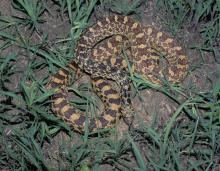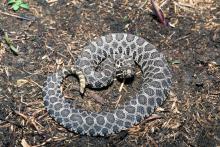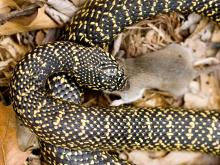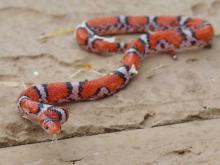Reptiles and Amphibians
Media

Species Types
Scientific Name
Heterodon nasicus
Description
The plains hog-nosed snake has probably been extirpated from Missouri. It has a sharply upturned snout, black pigment on the underside of the tail, and was only known from the loess hill region of extreme northwest Missouri.
Media

Species Types
Scientific Name
Pantherophis ramspotti
Description
The western foxsnake is a moderately large snake with distinct brown blotches. In Missouri, it is rare and found only in our far northwestern counties.
Species Types
Scientific Name
Pantherophis vulpinus
Description
The eastern foxsnake is extremely similar to the western foxsnake and is mainly identified by its different geographic distribution: in Missouri, this rare species is found only in a few counties along the Mississippi River floodplain north from St. Louis.
Media

Species Types
Scientific Name
Pituophis catenifer sayi
Description
Missouri's largest snake, the bullsnake may hiss loudly and vibrate its tail when alarmed, but it is nonvenomous. This species is extremely valuable in controlling destructive rodents.
Media

Species Types
Scientific Name
Sistrurus tergeminus tergeminus
Description
The prairie massasauga is a medium-sized rattlesnake associated with bottomland prairie habitats in north-central and northwestern Missouri. This endangered species is shy, reclusive, and nonaggressive.
Media

Species Types
Scientific Name
Clonophis kirtlandii
Description
Kirtland’s snake is extremely rare and occurs in only a few states in the Midwest. It lives in crayfish burrows in grassland habitats that are damp and near a stream or wetland. It is restricted in Missouri to a few northeastern counties.
Media

Species Types
Scientific Name
Coluber constrictor flaviventris (eastern yellow-bellied racer) and Coluber constrictor priapus (southern black racer)
Description
The eastern yellow-bellied racer is uniformly tan, brown, olive, blue, gray, or nearly black on top, with a yellow, cream, or light blue-gray belly. It occurs nearly statewide. The southern black racer subspecies also lives in the southeastern half of the state.
Media

Species Types
Scientific Name
Thamnophis proximus proximus
Description
The orange-striped ribbonsnake is a type of gartersnake named for the attractive orange or yellow stripes running the length of its body, alternating with wide black stripes. It is found statewide, but seldom far from water.
Media

Species Types
Scientific Name
Lampropeltis holbrooki
Description
The speckled kingsnake is generally black, but a white or yellow spot in the center of most of the scales makes it look speckled. The belly is yellowish with some irregular black markings. A harmless, beneficial snake found nearly statewide.
Media

Species Types
Scientific Name
Cemophora coccinea copei
Description
One of Missouri's most brilliantly colored snakes is also extremely rare to find. The northern scarletsnake is similar in pattern and color to the more common red milksnake but has a red or orange snout and a spotless, white belly.
See Also
About Reptiles and Amphibians in Missouri
Missouri’s herptiles comprise 43 amphibians and 75 reptiles. Amphibians, including salamanders, toads, and frogs, are vertebrate animals that spend at least part of their life cycle in water. They usually have moist skin, lack scales or claws, and are ectothermal (cold-blooded), so they do not produce their own body heat the way birds and mammals do. Reptiles, including turtles, lizards, and snakes, are also vertebrates, and most are ectothermal, but unlike amphibians, reptiles have dry skin with scales, the ones with legs have claws, and they do not have to live part of their lives in water.





















